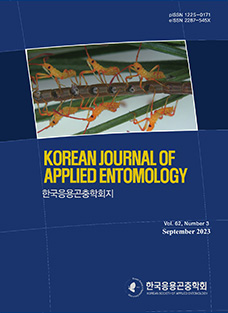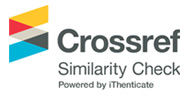A tribe Rhyparini is one of the tribes of well-known termitophilous scarabs in the subfamily Aphodiinae Leach, 1815 (Skelley, 2007). The tribe are probably considered synechthran in general morphology, but less so than Termitotrogini and Stereomerini, and also have symphilic-type trichomes. The typical Rhyparini are not found with termites, and could be described as weakly synechthran in morphology. Within Rhyparini, only the more or less aberrant taxa are actually found among termites, often being intermediate between the weaker synechthran-type and symphilic-type morphologies (Vårdal and Forshag, 2010).
The tribe Rhyparini include 77 species of 12 genera from the world (Pittino, 2006; Skelley, 2007), and Pittino (2006) provided a key to genus of Rhyparinae from the world.
Up to now, a total of nine species of two genera, Rhyparus Agassiz, 1846, Sybacodes Fairmaire, 1896, in the tribe Rhyparini have been recorded in the Palaearctic region: eight species of Rhyparus and one species of Sybacodes and these species have been recorded from Japan (three species), China (one species), Taiwan (five species) (Ochi, 2001; Löbl, 2006). However, there is no recorded species of the tribes has been found from the Korean peninsula.
In the present study, we report on the tribe Rhyparini from Korea for the first time, based on Rhyparus azumai azumaiNakane, 1956. A redescription, illustrations of detailed diagnostic characters including male genitalia and a key to Korean tribe of the subfamily are provided.
Materials and Methods
All samples examined for this study were collected in South Korea by using light trap in 2014.
For illustrations, we used a Leica Microsystems M 205A Stereozoom (Leica, Solms, Germany), which was connected with a digital camera, Leica Microsystems DE/DFC 49. Images were then manipulated with LAS (version 4.1.0., Leica Microsystems (Switzerland), in the Korea National Arboretum (Pocheon, South Korea).
Measurements and abbreviations used in this paper are as follows: BL, maximum length of body from median clypeus to elytra at apex in dorsal view; HW, maximum width of head in frontal view; PL, maximum length of pronotum measured along median line in dorsal view; PW, maximum width of pronotum at its widest point in dorsal view; EL, length of elytron from base to apex along median line in dorsal view; EW, maximum width of elytra in dorsal view.
The morphological terminologies were adopted from Cartwight & Woodrff (1969), Krikken & Huijbregts (1987) and Mencl & Rakovič (2013).
The materials used in this study are deposited at the Insect Collection of Korea National Arboretum, Korea Forest Service, Pocheon, Gyeonggi Province, South Korea.
Systematic Accounts
Family Scarabaeidae Latreille, 1802
Tribe Rhyparini Schmidt, 1910 줄똥풍뎅이족(신칭)
Rhyparini Schmidt, 1910: 119.
Remarks. The tribe Rhyparini can be distinguished from other tribes of the subfamily Aphodiinae by the following combination of characters: clypeus usually bidentate though sometime feebly so, inflexed edge medially obtusely angulate; frons and vertex with tufts of setae or longitudinal tubercles; pronotum with longitudinal costae equally spaced in at least posterior half of disc, lateral pronotal edge at least feebly bilobed in anterior half; elytra costae, costae varying on height, number and spacing, elytral apices frequently bulbous, epipleura narrow; posterior prosternal process hastate; antenna with nine segments, club with three segments, segments of club short and compact (Howden, 1995).
Genus Rhyparus Agassiz, 1846 줄똥풍뎅이속(신칭)
Rhyparus Agassiz, 1846: 328. Type species: Rhyparus helephoroides Fairmaire, 1893.
Rhyparus azumai azumaiNakane, 1956 광양줄똥풍뎅이(신칭)
Rhyparus azumaiNakane, 1956: 123.
Redescription.
Color: Head, pronotum and elytra mostly covered with grey coating, with faint metallic shine. Antenna, tarsus and palpi yellowish brown. Tibia dark brown.
Morphology (Fig. 1A–F): Head with minute punctures and perceptible macrosetae, with shallow anterior clypeal emargination, with upturned angle each side of it, considerable lateral emargination and next rather widely rounded angle separated by small emargination from strongly protruding round gena. Clypeus margin with actually two edges in upper and lower; upper edge is sharp and distinct; lower edge is indistinct, only partially observable from above. Clypeal disc with minute punctures, appressed setae, ringed with a deep groove; the convexity with a pair of short ridges. Frons with four longitudinal ridges; ridges of median pair situated each side of head midline similarly as two short ridges on clypeal convexity; distances between neighbouring median and lateral ridges larger than that between two median ones, ridges of outer pair distinctly longer than ridges of median pair. Pronotum with eight not sharp but considerably convex ridges and seven longitudinal furrows. Ridges of pronotum with hardly perceptible macrosetae, first (median) pair continuous and convergent at anterior 1/3, constricted between deep transverse fossae present on each side in the second and third furrows and interrupting ridges of the second pair. Furrows of pronotum with minute appressed macrosetae, median furrow of pronotum with two or more irregular longitudinal rows of rather coarse punctures throughout. Lateral margins of pronotum with two edges in upper and lower, upper edges is sharp and distinct. Elytra elongate. Each elytron with five costae, five flat intervals, apical bulbous area. Costae of each elytron with minute, appressed, hardly perceptible, obliquely backward directed setae. 1 st , 2 nd and 3 rd flat intervals of each elytron with two rows of punctures, punctures of 1 st flat intervals considerably deep, punctures of 2 nd flat intervals shallow. 3 rd and 4 th flat intervals with very faint punctures or definite punctures. Leg slim at base, dense spinules, pubescent. Protibia and metatibia with tooth at inner and outer apical. Ventral surfaces mostly with punctures bearing minute, pale, appressed setae. Aedeagus as in Fig. 1 G, H, I, J.
Measurements.
Male (n = 1): BL = 5.80 mm, HW = 1.64 mm, PL = 1.42 mm, PW = 1.85 mm, EL = 3.52 mm, EW = 2.11 mm.
Female (n = 1): BL = 6.35 mm, HW = 1.85 mm, PL = 1.59 mm, PW = 2.03 mm, EL = 3.67 mm, EW = 2.26 mm.
Material examined. 1♂, 1♀, Daejuk-ri, Okgok-myeon, Gwangyang-si, Jeonnam, Korea, 22.VIII.2014. Sang-Su Kim leg.
Distribution. South Korea (new record) (Fig. 2), Japan (Honshu, Kyushu, Shikoku).
Remarks. Since Rhyparus azumai azumai Nakane was first described from Japan (Nakane, 1956), the species has been just known as an endemic species to Japan. However, the species is recorded from South Korea for the first time. Ochi (2001) divided this species into two subspecies, R. azumai azumai Nakane and R. azumai loebli (Paulian). R. azumai azumai Nakane can be distinguished from R. azumai loebli (Paulian) by having characteristics: apical bulbous area of each elytron briefly and strongly sinuous near external protrusion in dorsal view, with the external protrusion distinct, well prominent laterally; lower edge of clypeus margin indistinct; metatibiae relatively short and stout (Ochi, 2001).
Key to the Korean tribes of subfamily Aphodiinae (modified from Kim (2012))
-
Pronotum and elytra with longitudinal costae ··················· ································································· tribe Rhyparini
-
Head surface granulate. Pronotum with transverse furrows and deep, large, longitudinal median furrow; occasionally with one to two short, transverse furrow. Upper meta-tibial spur with large, truncate apex; metatarsi short, triangular ···· ···························································· tribe Psammodiini
-
Head with suddenly declined frontal and lateral surfaces, usually without frontal tubercle. Gena large, directed downward. Metatibiae without transverse carinae ········ tribe Eupariini









 KSAE
KSAE





